Dubbed the world’s most powerful mini workstation, the new HP Z2 Mini G9 is the newest generation of the company’s high-performance mini desktop PC. The new compact release from HP features a range of 12th gen Intel Core processors, up to 8TB of storage, and NVIDIA RTX professional graphics, making this high-end machine perfect for simultaneously running 3D design projects and other professional applications. Users will also have the choice of having Windows 11 Pro, WSL2, or Linux operating systems for their new Z2 Mini G9.
We’ve loved the Z2 line for years at StorageReview, as they have an impressive amount of power available packed inside such a small form factor. So, as you can imagine, we were very excited to get our hands on one of these systems to discuss and put through our extensive benchmarking in our labs. This compact workstation is highly customizable for its size and form factor, allowing users and organizations to create the system that best works for them.
HP Z2 Mini G9 Components
Like its predecessors, the most noticeable change with the new-gen Z2 Mini is under the hood, featuring a range of new components. HP offered eleven different pre-configurations for their last-gen HP Z2 Mini G5, with the ability to customize those builds even further. We expect more of the same when the G9 hits general availability in the next few weeks.
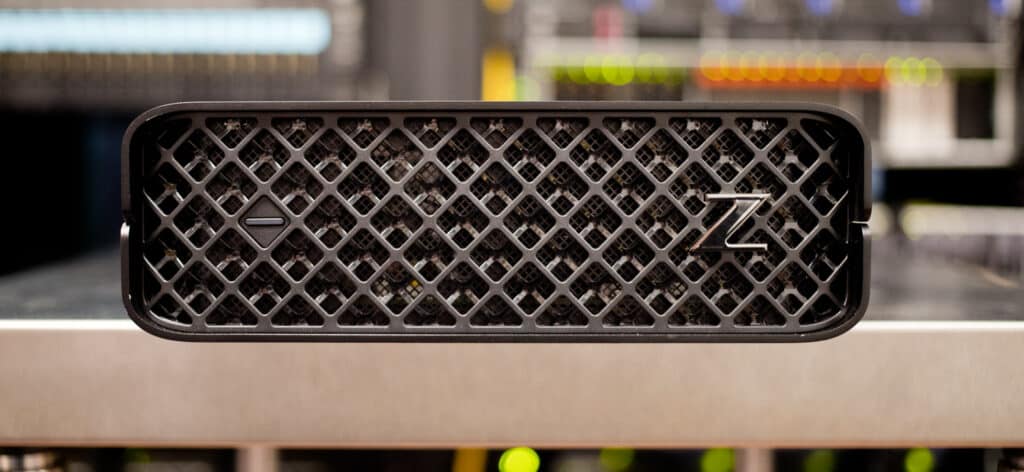
That said, users will be able to equip the Z2 Mini G9 with a range of 12th generation Intel Core CPUs, including budget-friendly Intel Core i3 processors all the way up to the powerful Intel Core i9-12900K processor (3.2 GHz, up to 5.2 GHz w/Boost, 16 cores), with a few other i5 and i7 models in between. Thankfully our review build starts off strong with the top bin CPU.
Users can also have the choice of several entry-to-mid-level professional graphics cards. More demanding users will opt for the fastest option, which is a full-size RTX A2000 professional GPU (launched in November 2021). The A2000 features up to 12GB of memory, four mini DisplayPort 1.4 ports, and second-generation RT cores. The A2000 is what came in our review system.
Previously, HP used a modified notebook version NVIDIA GPUs inside the Mini Z2; however, with the G9 generation, users will have a full-sized RTX model at their disposal. This is a pretty big deal as this means higher performance and flexibility for professional applications.
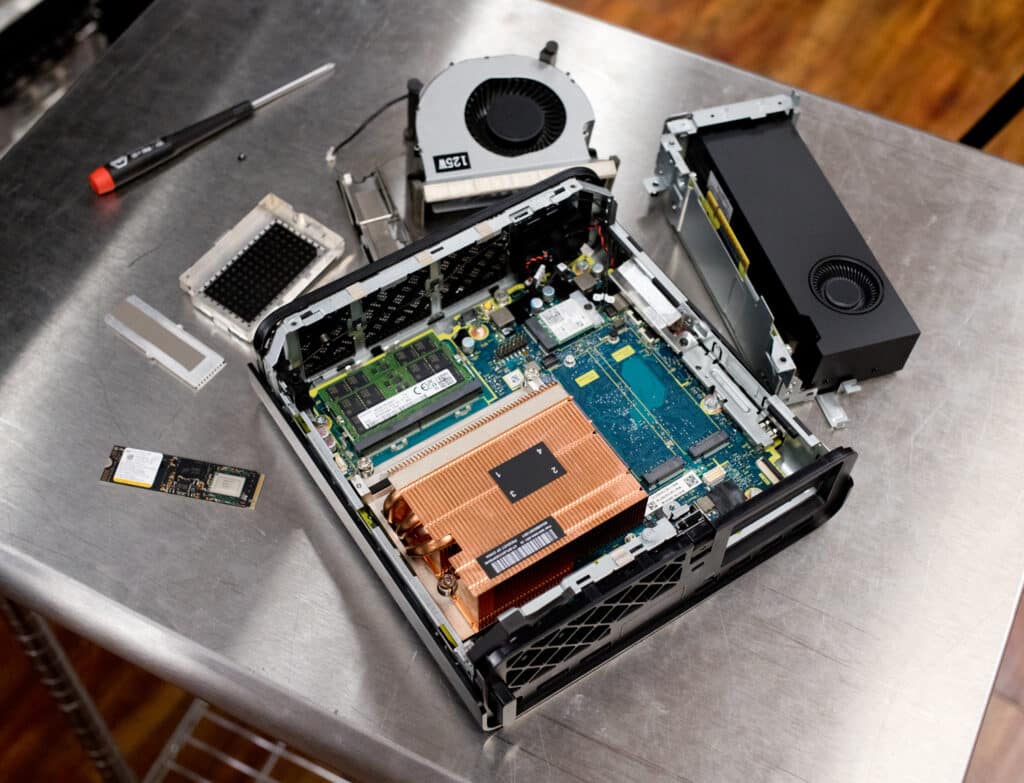
There are a few other GPUs to choose from, including the NVIDIA T400 (4GB/2GB), NVIDIA T600 (4GB), and NVIDIA T1000 (8GB/4GB), all of which cater to a range of different professional needs. In addition, depending on which GPU model you go with, the new Z2 Mini G9 will offer support for up to 8 displays at 4K resolution, so you will be able to see all your windows from your professional apps no matter how many you have loaded up.
The HP Z2 Mini G9 also features a range of storage options. There are two onboard M.2 PCIe Gen4 slots for up to 8TB of speedy NVMe storage (i.e., HP Z Turbo Drives) along with RAID data storage capabilities. If you don’t mind rolling your own storage, you could of course outfit this with 8TB SSDs to punch up the capacity to 16TB. Our review system came with a single HP Z Turbo SSD (1TB Micron 3400 SSD). It’s equipped with a moderate heatsink to help ensure the drive stays as cool as possible in this limited footprint.
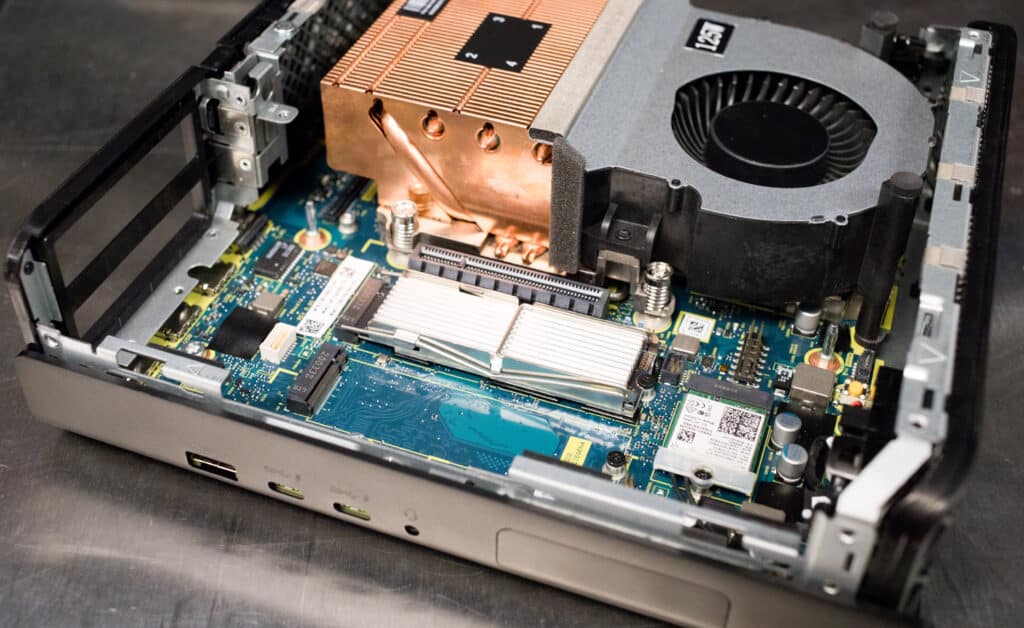
Memory options run from 4GB to 64GB of DDR5-4800 SODIMM RAM (ECC or nECC). This is the first small form factor system we’ve seen leveraging DDR5, where previous systems like the latest Dragon Canyon NUC capped out at DDR4-3200. This might be a bit less than what you see with other workstations, though this is due to its size limitations. It’s also more than enough to run most of your resource-hungry apps on a mid-range workstation like the Z2 Mini series. Our review system shipped with 64GB.
Users can also equip the G9 Mini with a power supply that features up to 280W, which is especially needed for those who have a top-tier component build.
For those who would enjoy seeing a video teardown of the HP Z2 Mini G9, we posted a clip to our social media channels when the system came in:
HP ZCentral Remote Boost
One of the more interesting features HP offers their professional workstation lines is HP ZCentral Remote Boost. This technology is more important than ever, as businesses and organizations around the globe are moving towards a more remote workforce. Where technology like this was more “nice to have” just 5 years ago, it is now more of a requirement mainly due to the global events of the last couple of years.
HP ZCentral Remote Boost is the company’s remote connection software (previously known as HP Remote Graphics Software or RGS) and comes bundled with all HP Z Workstations, license-free, including the new Z2 Mini G9. It has been designed for use with physical workstations rather than virtual machines (VM). In essence, Remote Boost connects an endpoint device to a Z workstation in your office or home, allowing users to access the system for graphics-intensive work via the end-point device.
A user can access their workstation no matter where it might reside: in a data center, data closet, or even at the work desk where you use to be set up in the office. If the Receiver can contact the Sender system over the network, the compute resources can be fully remoted–even in a WAN environment when VPNs are present.
Overall, we found our end-user experience with HP Remote Boost to be quite excellent. I highly encourage you to read our whitepaper by Tom Fenton, How it Works: HP ZCentral Remote Boost, for a detailed examination of this useful technology, which is now more relevant than ever.
HP Z2 Mini G9 Specifications
| Available Operating Systems |
|
| Processor family |
|
| Form factor | Mini |
| Memory slots | 2 SODIMM |
| Internal storage |
|
| Graphics | Discrete: NVIDIA T400 4GB; NVIDIA T1000 8GB; NVIDIA RTX A2000 12GB; NVIDIA T400 2 GB; NVIDIA T600 4 GB; NVIDIA T1000 4GB |
| Audio | Realtek ALC3205-VA2-CG, 2.0W internal mono speaker |
| Expansion slots | 2 M.2 2280 PCIe 4 x4; 1 M.2 2230 for WLAN; 1 PCIe 4 x8 (PCIe Low Profile connector) |
| Ports and Connectors |
Optional Ports: Flex IO right side – choose one of the following options: 1 Dual SuperSpeed USB Type-A 5Gbps signaling rate, 1 serial; Flex IO left side – choose one of the following options: 1 DisplayPort 1.4 HBR3, 1 HDMI 2.0b, 1 VGA, 1 Dual SuperSpeed USB Type-A 5Gbps signaling rate, 1 SuperSpeed USB Type-C 10Gbps signaling rate (USB Power Delivery, Alt Mode DisplayPort™), 1 GbE LAN, 1 Thunderbolt 3 (40Gbps signaling rate) with SuperSpeed USB Type-C 10Gbps signaling rate, 2.5 GbE LAN. 10GbE LAN(10GBase-T), USB-based Serial port option, 1GbE Fiber LC NIC |
| Input devices | HP Wired Desktop 320K keyboard; HP Wired Desktop 320MK Mouse and Keyboard; HP 125 Wired Keyboard; HP 655 Wireless Keyboard and mouse combo; HP 975 Wireless Keyboard; HP 455 Programmable Wireless Keyboard9; HP Wired Desktop 320M mouse; HP wired desktop 128 laser mouse; HP 125 Wired Mouse; HP Creator 935 Black Wireless Mouse9; |
| Communications |
|
| Software | HP PC Hardware Diagnostics UEFI; HP Support Assistant; HP PC Hardware Diagnostics Windows; ZCentral Remote Boost; HP Image Assistant; HP Manageability Integration Kit; Performance Advisor 3.0; |
| Security management | HP Secure Erase; HP Sure Click; HP BIOSphere Gen6; HP Sure Admin; Hood Sensor Optional Kit; HP Client Security Manager Gen6; HP Sure Start Gen7; HP Sure Recover Gen4; HP Sure Sense Gen2; HP Sure Run Gen5 |
| Security Software Licenses | HP Wolf Pro Security Edition |
| Power | 180 W external power adapter, up to 89% average efficiency, active PFC; 280 W external power adapter, up to 89% average efficiency, active PFC |
| Dimensions | 8.3 x 8.6 x 2.7 in 21.1 x 21.8 x 6.9 cm (Standard desktop orientation.) |
| Weight | Starting at 5.29 lb Starting at 2.4 kg (Exact weight depends on configuration.) |
HP Z2 Mini G9 Design and Build
Though similar in size, the new Z2 Mini G9 sports a completely different look than HP’s previous generation Mini. The front of the workstation is now rounded and the entire front panel sports a large ventilation grille with a power button and Z branding (the corners of the previous G5 model only had ventilation on the corners and has a polygon-like shape design).
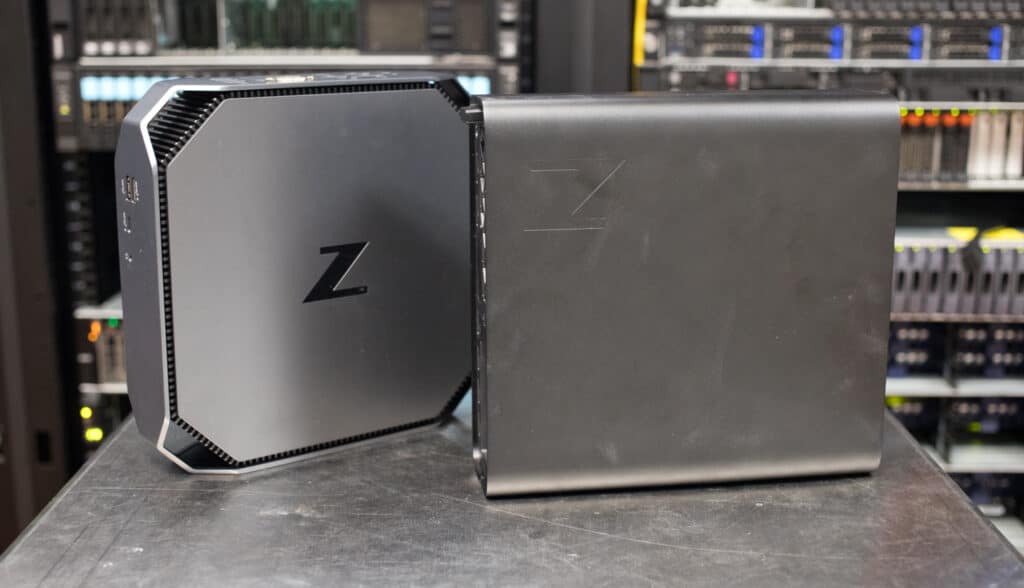
This little guy will easily fit anywhere where you need it (whether it’s in an office or a home) while its flexible, modern design will look nice anywhere you put it. You can also mount it behind a monitor, attach it under a desk or even install it on a rackmount in your data center, which is handy for Remote Boost. It’s easily portable as well if you want to move it to and from different locations.
We only had one minor gripe with the enclosure–specifically the sides and top panel. As is clear in the image below, the new Z2 Mini is essentially a dust and smear magnet. So if you want to keep it nice and clean, you’ll have to be a bit extra careful. Though despite that minor caveat, we really liked the new design ID.
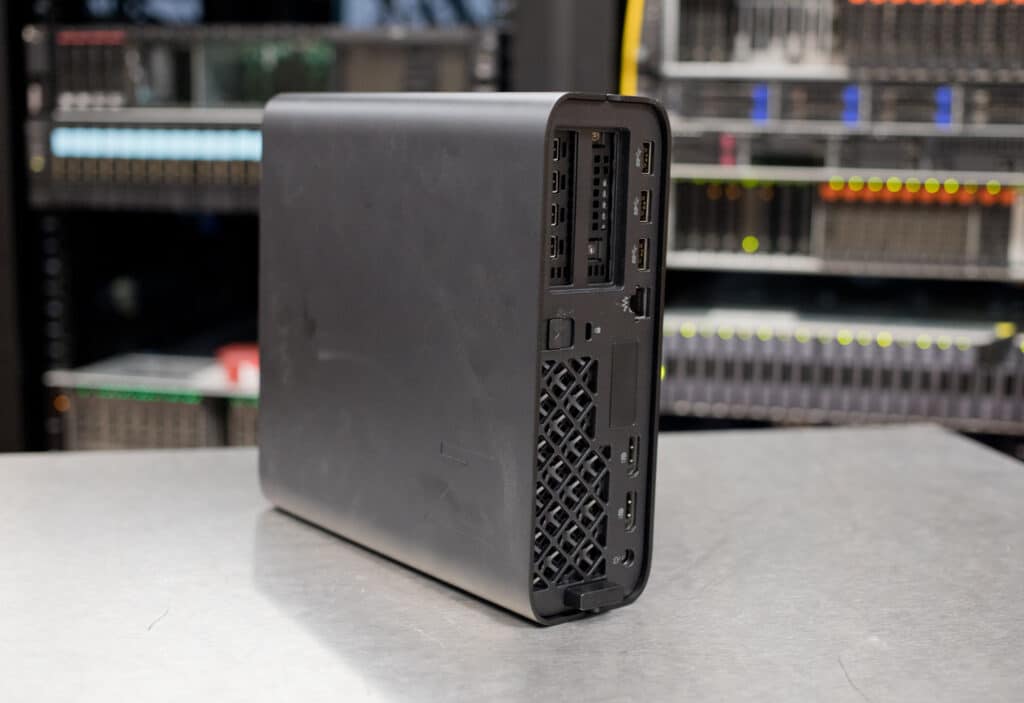
The back panel is home to most of the connectivity, including one RJ-45 port, two DisplayPort 1.4 ports, and three SuperSpeed USB Type-A 10Gbps (signaling rate) ports, which come standard with all builds.
Optional ports include:
- Flex IO right side: one Dual SuperSpeed USB Type-A 5Gbps signaling rate, one serial;
- Flex IO left side: one DisplayPort 1.4 HBR, 1 HDMI 2.0b, one VGA, one Dual SuperSpeed USB Type-A 5Gbps signaling rate, one SuperSpeed USB Type-C 10Gbps signaling rate (USB Power Delivery, Alt Mode DisplayPort), one GbE LAN, one Thunderbolt 3 (40Gbps signaling rate) with SuperSpeed USB Type-C 10Gbps signaling rate, 2.5 GbE LAN. 10GbE LAN(10GBase-T), USB-based Serial port option, 1GbE Fiber LC NIC
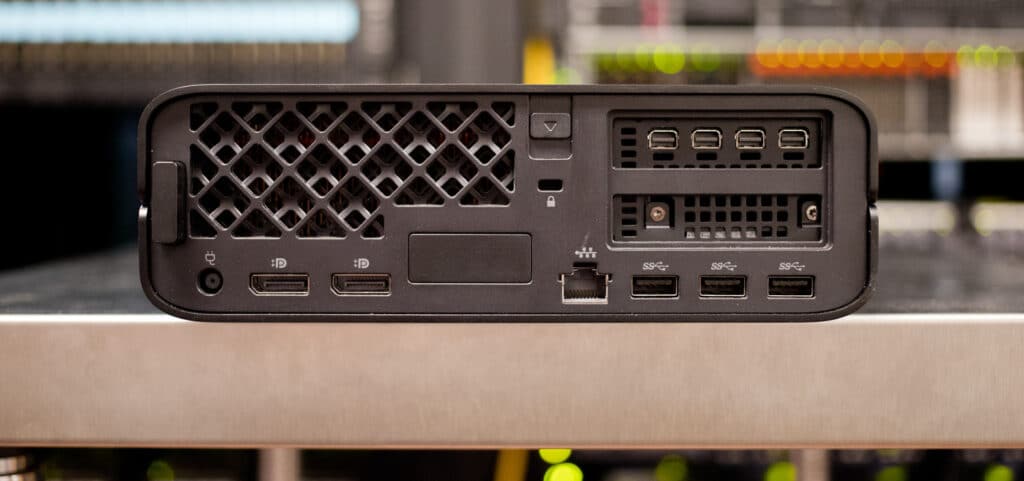
The side panel features the rest of the connectivity: one headphone/microphone combo, a SuperSpeed USB Type-A port (at 10Gbps signaling rate – 1 charging), and two SuperSpeed USB Type-C (20Gbps signaling rate) ports.
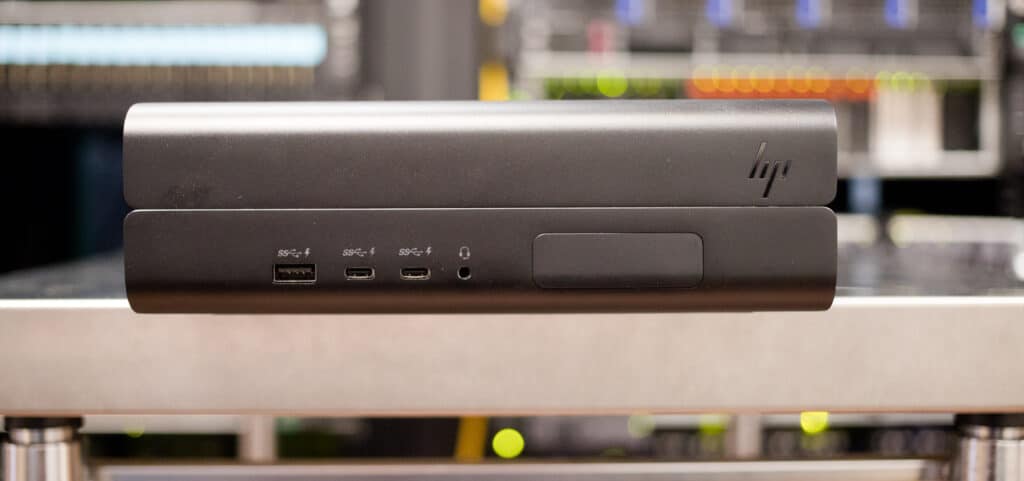
After opening up the top cover (which is very easy to do), you’ll see an intelligent and compactly laid-out set of components.
The new Z2 Mini is easily accessible so you can scale and upgrade it as your workloads increase. It features a new slide-out design with a tool-less interior while featuring standard-sized components so you can easily swap things like memory and GPUs. You can also easily connect to your peripherals via built-in I/O.
The dual M.2 slots are easily accessible on the right, which makes replacing and adding new SSDs quick and easy as well.
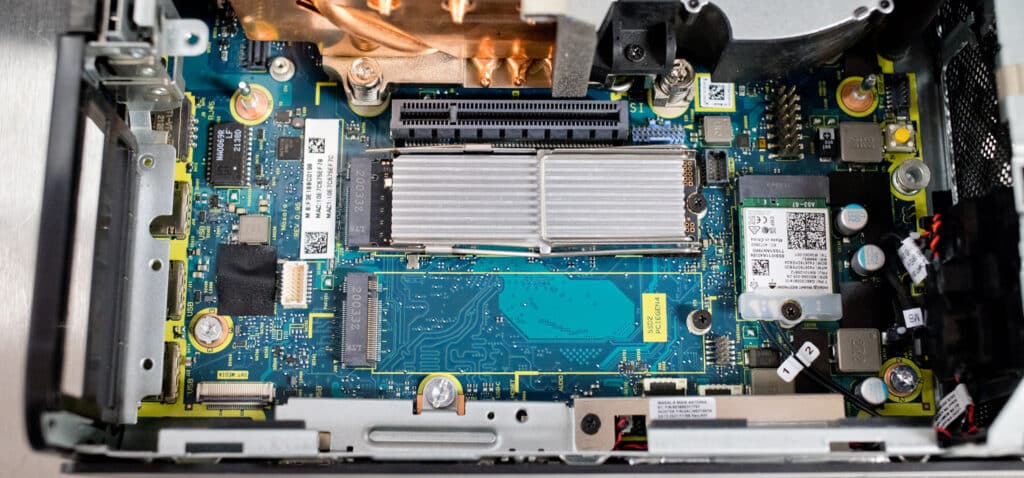
When you take away the 125W fan, you have access to the RAM (in our case, dual Samsung 64GB of DDR5 4800Hz sticks), which are clamped securely to the motherboard under a heat shield that we removed for the photo.
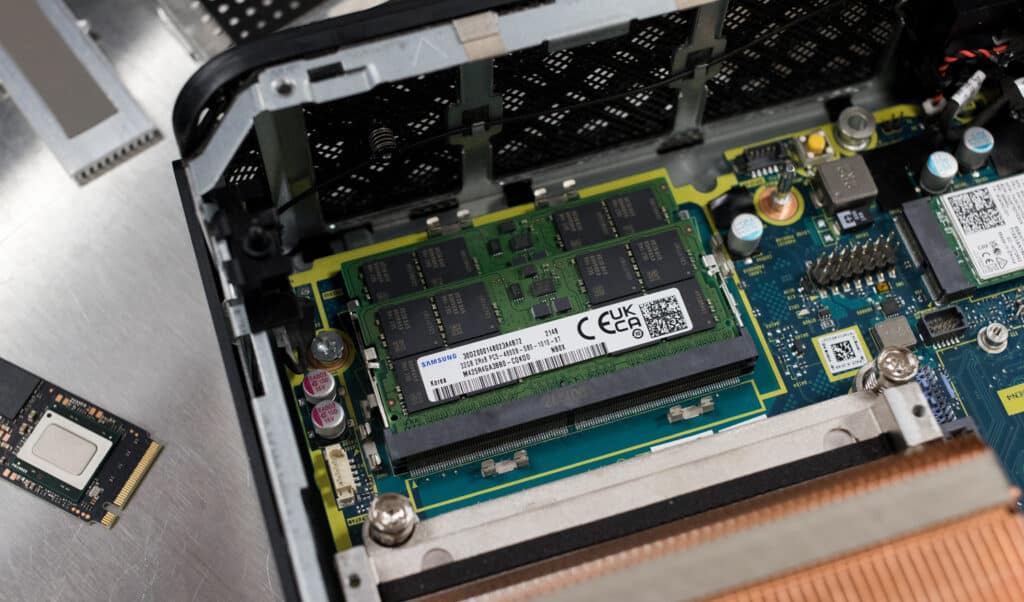
Below is a side-by-side comparison between the HP Z2 Mini G5 and the new G9 layout. The most notable difference is the full-size RTX A2000 card on the right side. The G9 also uses a little more space by squaring off the corners and is much better about ventilation.
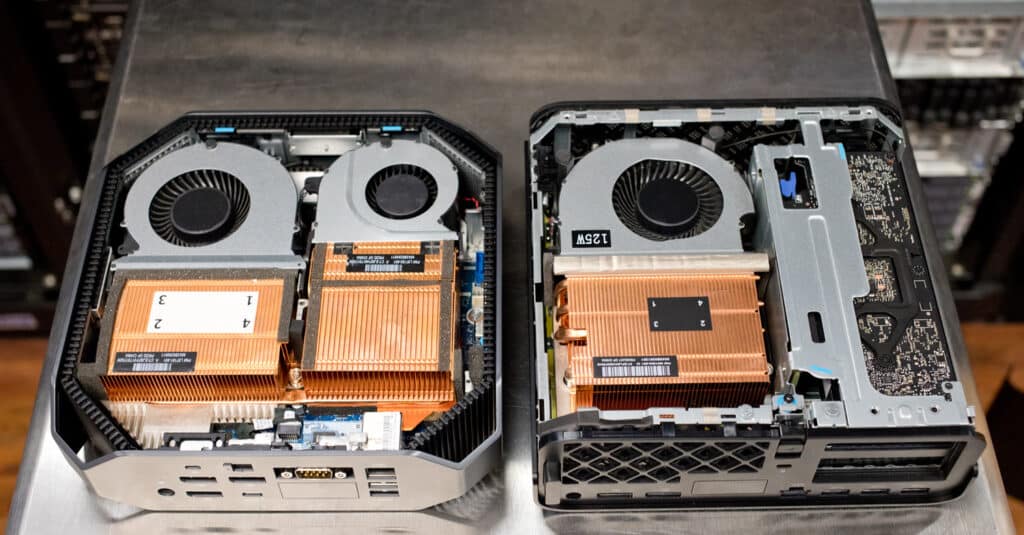
HP Z2 Mini G9 Performance
For the following tests and initial booting of the workstation, we connected the Z2 Mini G9 to a Lenovo 4K monitor via one of the DisplayPort ports. We also used the bundled Windows 11 Pro for all of our tests.
To gauge its performance, we put it through a range of unique benchmarking tests and compared them to the recently reviewed Intel NUC 12 Extreme, which has a similar setup. While these two compact workstations each have their own particular benefits in performance capabilities and applications, we wanted to show the full picture of how these would compare. We also want to show the difference in performance regarding RAM, as the HP Z2 Mini G9 is the first system we’ve seen with DDR5 SO-DIMM.
In some tests, we also compared it to the HP Z2 Mini G5 to demonstrate improvements over the older-gen workstation.
SPECworkstation 3
First up is SPECworkstation 3, which is a specialized test designed for benchmarking the key aspects of workstation performance by using over 30 workloads to test CPU, graphics, I/O, and memory bandwidth. The workloads fall into seven broad categories: Media and Entertainment, Product Development, Life Sciences, Energy, Financial Services, General Operations, and GPU Compute. We listed the broad-category results which represent an average for all the individual workloads in each category.
The results showed that the combination of the DDR5 SO-DIMM RAM, processor, and discrete GPU made for slightly better results than NUC 12 Extreme and significantly improved performance over its predecessor.
| System | HP Mini Z2 G9 NVIDIA RTX A2000 |
NUC 12 Extreme NVIDIA RTX A4000 |
HP Mini Z2 G5 NVIDIA Quadro T2000 |
| i9-12900K
64GB DDR5 SO-DIMM RAM |
i9-12900
16 cores @ 5.10GHz 32GB RAM |
i7-10700K
32GB of DDR4 RAM |
|
| M&E | N/A | N/A | 2.31 |
| ProdDev | 4.09 | 3.88 | 2.0 |
| LifeSci | 3.53 | 3.43 | 1.89 |
| Energy | 4.36 | 4.52 | 1.49 |
| Financial Services | 4.24 | 3.24 | 2.15 |
| General Operations | 2.85 | 2.77 | 1.93 |
| GPU Compute | N/A | 5.52 | 2.13 |
SPECviewperf 12.1/2020
SPECviewperf is considered to be the worldwide standard for measuring graphics performance based on professional applications. SPECviewperf runs 9 benchmarks called viewsets, which represent graphics content and behavior from actual applications, and include applications including 3D Max, CATIA, Creo, Energy, Maya, Medical, Showcase, Siemens NX, and Solidworks.
| SPECviewperf 12.1/2020 | |||
| System | HP Mini Z2 G9
NVIDIA RTX A2000 |
NUC 12 Extreme
NVIDIA RTX A4000 |
HP Mini Z2 G5
NVIDIA Quadro T2000 |
| i9-12900K 16 cores @ 5.20 GHz, 64GB DDR5 RAM | i9-12900 16 cores @ 5.10 GHz, 32GB DDR4 RAM | i7-10700K, 32GB DDR4 RAM | |
| 3dsmax | 138.71 | 92.45 | 26.65 |
| catia | 99.21 | 69.78 | 20.3 |
| creo | 154.25 | 118.65 | 45.39 |
| energy | 42.89 | 21.73 | 6.23 |
| maya | 334.1 | 227.22 | 72.11 |
| medical | 34.92 | 19.98 | 7.31 |
| snx | 446.73 | 298.97 | 109.76 |
| Solidworks | 166.42 | 107.7 | 5.08 |
7-Zip Compression Benchmark
The 7-Zip file archive tool has a built-in compression benchmark. We ran 10 passes using a 128MB dictionary size and all 24 CPU threads of our systems. Higher numbers are better. This test showcases the strengths of the faster DDR5 inside the Z2, whereas the NUC is limited by its DDR4 top-end.
| 7-Zip Compression Benchmark | ||
| System | HP Mini Z2 G9
64GB DDR5 RAM NVIDIA RTX A2000 |
NUC 12 Extreme
32GB DDR4 RAM NVIDIA A4000 |
| Compressing | ||
| Current CPU Usage | 2033% | 1979% |
| Current Rating/Usage | 4.372 GIPS | 2.953 GIPS |
| Current Rating | 88.990 GIPS | 58.434 GIPS |
| Resulting CPU Usage | 2049% | 1975% |
| Resulting Rating/Usage | 4.864 GIPS | 2.970 GIPS |
| Resulting Rating | 91.456 GIPS | 58.633 GIPS |
| Decompressing | ||
| Current CPU Usage | 2245% | 2330% |
| Current Rating/Usage | 4.642 GIPS | 4.117 GIPS |
| Current Rating | 108.383 GIPS | 95.932 GIPS |
| Resulting CPU Usage | 2341% | 2352% |
| Resulting Rating/Usage | 4.772 GIPS | 4.062 GIPS |
| Resulting Rating | 111.692 GIPS | 95.542 GIPS |
| Total CPU Usage | 2195% | 2163% |
| Total Ratings | ||
| Total Rating/Usage | 4.618 GIPS | 3.516 GIPS |
| Total Rating | 101.574 GIPS | 77.088 GIPS |
Esri
The Environmental Systems Research Institute (Esri) Performance Team designed their PerfTool add-in scripts to automatically launch the ArcGIS Pro. This application uses a “ZoomToBookmarks” function to browse various predefined bookmarks and create a log file with all the key data points required to predict the user experience. The script automatically loops the bookmarks three times to account for caching (memory and disk cache). In other words, this benchmark simulates heavy graphical use that one might see through Esri’s ArcGIS Pro software.
We test three models – Montreal, Philly, and Portland. Higher numbers are better.
| System | HP Mini Z2 G9
64GB DDR5 RAM NVIDIA RTX A2000 |
NUC 12 Extreme
32GB DDR4 RAM NVIDIA A4000 |
HP Mini Z2 G5
32GB DDR4 RAM NVIDIA Quadro T2000 |
| ESRI ArcGIS Pro 2.3 Montreal | |||
| Average FPS | 165.13 | 356.88 | 155.42 |
| Minimum FPS | 78.02 | 179.89 | 91.18 |
| ESRI ArcGIS Pro 2.3 Philly | |||
| Average FPS | 125.07 | 266.31 | 122.46 |
| Minimum FPS | 83.47 | 166.07 | 79.70 |
| ESRI ArcGIS Pro 2.3 Portland | |||
| Average FPS | 1,742.84 | 2,529.59 | 1,492.43 |
| Minimum FPS | 654.55 | 984.32 | 541.96 |
Blender
Blender is an open-source 3D modeling application. This benchmark was run using the Blender Benchmark utility. The score is samples per minute. Higher numbers are better.
| Blender Benchmark | ||
| System | HP Mini Z2 G9
64GB DDR5 RAM NVIDIA RTX A2000 |
NUC 12 Extreme
32GB DDR4 RAM NVIDIA A4000 |
| Monster | 954 | 1,621 |
| Junkshop | 584 | 929 |
| Classroom | 511 | 834 |
OctaneBench
OctaneBench is a benchmarking utility for OctaneRender, which is a 3D renderer with RTX support that is similar to V-Ray. Like Luxmark, OctaneBench is large GPU-dependent, so the differences are slight between our rig and the workstation. The similarity bodes well for the Core i9 systems; if your workload is GPU-dependent, spending all-out for a heavily threaded workstation CPU isn’t necessarily required. Higher scores are better.
| OctaneBench Benchmark | |||
| System | HP Mini Z2 G9
64GB DDR5 RAM NVIDIA RTX A2000 |
NUC 12 Extreme
32GB DDR4 RAM NVIDIA A4000 |
|
| Scene | Kernel | ||
| Interior | Info channels | 8.04 | 11.14 |
| Interior | Direct lighting | 25.04 | 39.12 |
| Interior | Path tracing | 31.60 | 49.57 |
| Idea | Info channels | 4.76 | 6.78 |
| Idea | Direct lighting | 18.73 | 29.88 |
| Idea | Path tracing | 22.77 | 36.24 |
| ATV | Info channels | 11.03 | 16.81 |
| ATV | Direct lighting | 25.61 | 43.13 |
| ATV | Path tracing | 32.08 | 52.16 |
| Box | Info channels | 6.50 | 9.33 |
| Box | Direct lighting | 23.38 | 38.33 |
| Box | Path tracing | 26.29 | 42.21 |
HP Z2 Mini G9 Thermal Implications
Any time we consider small form factor systems, the balance of size vs thermals comes into play. Thermals are of particular note in this case because the Intel i9-12900K CPU is notorious for running hot. Specifically, the CPU throttles performance as the performance cores hit 100C.
While this may show up in systemwide tests as a lower performance score, these tests are often weighing heavily on some other component, like the GPU, DRAM, or storage for instance. To get a better idea of CPU impact because of the additional challenges when it comes to offloading heat from small systems, we ran a Blender workload specifically for the CPU to simulate a worst-case scenario. We compare these stats to our StorageReview i9-12900K processor full-sized test rig.
| Blender Benchmark (CPU only) | ||||
| System | HP Mini Z2 G9, i9-12900K (1st pass) 100C max |
HP Mini Z2 G9, i9-12900K (2nd pass) 100C max |
StorageReview i9 Test Rig, i9-12900K (1st pass) 82C max |
StorageReview i9 Test Rig, i9-12900K (2nd pass) 82C max |
| Monster | 144.57 | 138.4 | 189.87 | 189.76 |
| Junkshop | 84.25 | 83.76 | 105.94 | 105.80 |
| Classroom | 81.15 | 79.1 | 90.65 | 90.56 |
The Z2 Mini G9 hits thermal throttling, posting temps of around 100C on all of its P cores. It also had slower back-to-back results. That said, trade-offs are part of the small form factor engineering process, if you push the system hard on a continuous basis you will see lower performance than a larger system with more cooling capabilities.
The HP Z2 Mini G9 for Homelab
While Alder Lake CPUs bring many advancements, broad virtualization support is not one of them. The CPUs with combined performance and efficiency cores cause nightmares for hypervisors. While the Mini’s NIC is supported by VMware, the multi-core type CPUs are not, as can be seen in the capture below.
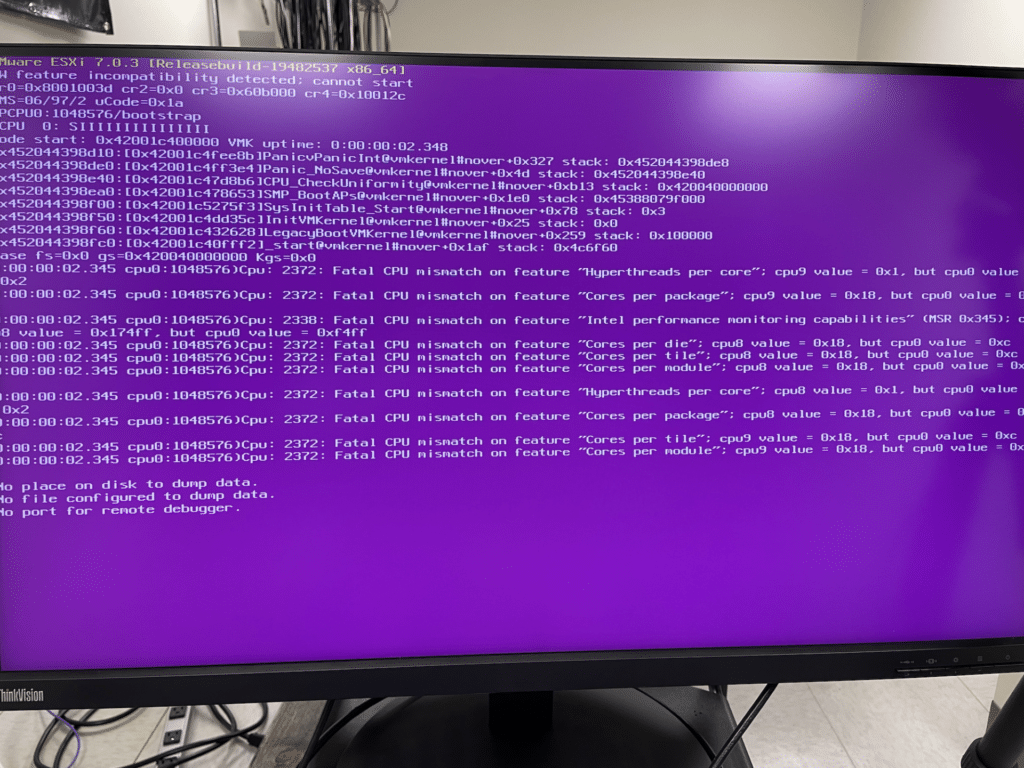
Some have kludged together workarounds in VMware and other hypervisors. But ultimately we advise that you look elsewhere at this time when it comes to using an Alder Lake system with the two core types in a homelab environment.
Conclusion
The HP Z2 Mini G9 is a successful follow-up to the G5, surpassing the previous-gen model in every way. This is one of the more uniquely, compact workstations available on the market. But don’t let its size fool you though, it is capable to offer some great performance for its class. Users will also have a range of components to customize the new HP system, which will certainly suit most mid-range workstation needs involving resource-intensive professional software. Like all other Z-systems, it is compatible with HP’s Remote Boost technology, which allows you to effectively access the power of the new Mini remotely.
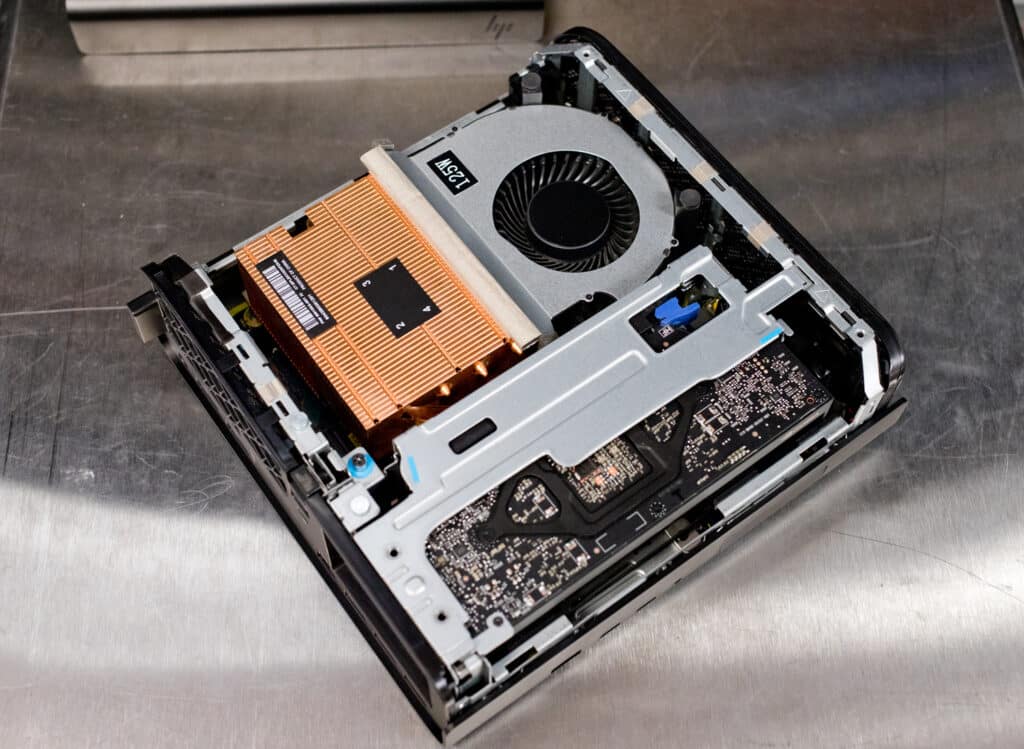
Users can outfit the new Mini with 12th generation Intel Core CPUs, including the Intel Core i9-12900K processor (3.2 GHz, up to 5.2 GHz w/Boost, 16 cores, one of the more powerful CPUs designed specifically to handle professional workloads the system is meant for. The biggest improvement component-wise over the G5 model is its use of full-size GPUs, including the RTX A2000 professional 12GB. Prior to this, the Mini line used modified notebook versions of the NVIDIA GPUs, which had less flexibility concerning potential performance output.
In addition to the new CPU and GPU options, users can choose from a range of storage including a couple of M.2 HP Z Turbo M.2 drives via the dual onboard Gen4 NVMe slots. The Mini G9 can also support up to 64GB of DDR5-4800 SODIMM RAM. This is the first time we’ve seen a professional workstation use the smaller memory module type in DDR5-based technology.
HP’s Z2 Mini line has always been an interesting piece of technology that we always look forward to testing in our labs. With its high-end component availability, which can easily be accessed and upgraded via its toolless design, coupled with extensive rack mounting support, the newest generation of the line is more flexible and powerful than ever.
In our testing, the G9 is a clear advancement over the G5. Much of this is uplift in components, but we cannot underscore enough the importance of the move to a full-size slot load GPU. This gives the system so many more options in terms of GPU choice and better overall performance. The HP even beat out the latest Intel NUC in a few spots, which had an A4000 inside. If we have any complaints in terms of performance, it’s that the CPU gets hot and will throttle under intensive load. That’s ultimately going to be up to the buyer in terms of mapping workload, CPU, and workstation footprint into their decision matrix. Those with footprint flexibility should look at the larger Z workstations, which have more cooling.
That said, the HP Z2 Mini G9 is overall a truly stunning system. HP calls this the most powerful workstation of its size. We’ve seen a lot of SFF platforms and while we’re quick to be the naysayer, on this count HP is quite correct. The G9 is a noticeable update to HP’s line of Mini workstations and it is clearly a system that can tackle most professional workloads.




 Amazon
Amazon